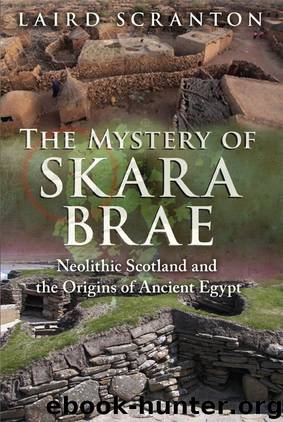The Mystery of Skara Brae by Laird Scranton

Author:Laird Scranton
Language: eng
Format: epub
Tags: Ancient Mysteries
Publisher: Inner Traditions
Published: 2016-11-04T00:00:00+00:00
16
CORRELATING REGIONAL KINGSHIPS AT 3000 BCE
In our outlook on the roots of pharaonic rule in Egypt, the establishment of dynastic kingship served as a finalizing stage in the instructed system of agriculture that defines the archaic civilizing plan. Through this act (the implementation of a self-sustaining state) a major educational step was achieved, civilization could be said to have taken root, and the primary goals of the civilizing plan would have been accomplished. Support for this view is found in the Egyptian word for “king,” which Budge pronounces suten. (He notes in his dictionary entry that “in the Early Empire the reading [of the word] . . . was nesu.”1) The term nes/ness is one that we associate with the locales of Orkney Island and Scotland. In Egypt, the word nes implies a concept of authorized ownership that rises to the level of legal property. The Dogon term su refers to an agreement. In light of those definitions, the combined term nesu would imply kingship that was delegated from an authority by legal agreement. Symbolically, the word suten reads “agriculture” “established” . In other contemporaneous cultures we have studied, such as ancient China, a primary accomplishment that is attributed to the earliest mythical kings is the establishment of agriculture. By comparison, the Dogon have no documented word for “king” but only have a term for chieftainship that they pronounce faro.
To all outward appearances, Orkney Island served as a kind of pre-dynastic instructional center, and its apparent focus was primarily on agriculture. The pastoral farming life that clearly thrived for centuries on the island bore a relationship to the cosmology enshrined there that is similar to the one borne by dynastic Egyptian culture to its comparable creation tradition, which the Egyptians also felt compelled to enshrine in stone. In prior books of this series, we have correlated many different aspects of Dogon civic life, religion, and language to likely counterparts in ancient Egypt. So, to the extent that Dogon culture accurately reflects elements of life found at Skara Brae, then by a transitive property we might interpret Skara Brae to have been a kind of model for early Egyptian farming culture.
From this perspective, we suggest that Orkney Island represented the real-world incarnation of the Egyptian Sekhet-Aaru, or Field of Reeds, a term that, based on both Dogon references and Egyptian glyph images, we interpret to represent the concept of a cultivated field. However, there are further complexities to the Egyptian term aaru, a word that Budge defines to mean “reeds.”2 When we examine Budge’s dictionary entry for the word, we notice that one of his spellings for the word is given with a single glyph, one that presents the image of a hemispheric sun with rays emitting from it .3 This glyph is a close correlate to a carved figure found at Newgrange, a prehistoric passage tomb in Ireland that is estimated to have been constructed in the same era as Skara Brae, also at around 3200 BCE .4 In other
Download
This site does not store any files on its server. We only index and link to content provided by other sites. Please contact the content providers to delete copyright contents if any and email us, we'll remove relevant links or contents immediately.
The Daily Stoic by Holiday Ryan & Hanselman Stephen(3263)
The Fate of Rome: Climate, Disease, and the End of an Empire (The Princeton History of the Ancient World) by Kyle Harper(3030)
People of the Earth: An Introduction to World Prehistory by Dr. Brian Fagan & Nadia Durrani(2711)
Ancient Worlds by Michael Scott(2648)
Babylon's Ark by Lawrence Anthony(2646)
The Daily Stoic by Ryan Holiday & Stephen Hanselman(2520)
Foreign Devils on the Silk Road: The Search for the Lost Treasures of Central Asia by Peter Hopkirk(2442)
India's Ancient Past by R.S. Sharma(2432)
MOSES THE EGYPTIAN by Jan Assmann(2393)
The Complete Dead Sea Scrolls in English (7th Edition) (Penguin Classics) by Geza Vermes(2254)
Lost Technologies of Ancient Egypt by Christopher Dunn(2207)
The Earth Chronicles Handbook by Zecharia Sitchin(2202)
24 Hours in Ancient Rome by Philip Matyszak(2064)
Alexander the Great by Philip Freeman(2044)
Aztec by Gary Jennings(1990)
The Nine Waves of Creation by Carl Johan Calleman(1897)
Curse Tablets and Binding Spells from the Ancient World by Gager John G.;(1851)
Before Atlantis by Frank Joseph(1828)
Earthmare: The Lost Book of Wars by Cergat(1806)
